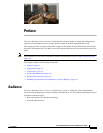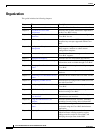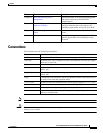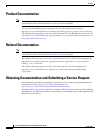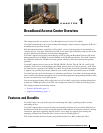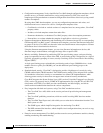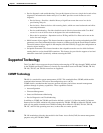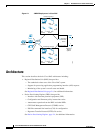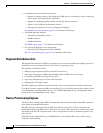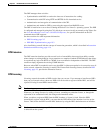
1-2
Cisco Broadband Access Center 3.8 Administrator Guide
OL-27172-01
Chapter 1 Broadband Access Center Overview
Features and Benefits
• Configuration management: Vastly simplified in Cisco BAC through configuration templates, which
provide an easy, yet flexible mechanism to assign configurations for CPE. You can use the
template-processing mechanism to customize configurations for millions of devices by using a small
number of templates.
By using these XML-based templates, you can set configuration parameters and values, and
notification and access controls on a device. Configuration templates allow:
–
Conditionals, to include or exclude sections of a template based on, among others, Cisco BAC
property values.
–
Includes, to include template content from other files.
–
Parameter substitution, to substitute Cisco BAC property values into template parameters.
–
Prerequisites, to evaluate whether the template is applicable to a device at given time.
• Firmware management: Maintaining and distributing sets of firmware image files to corresponding
CPE through the Cisco BAC system. A firmware rules template, associates the firmware image files
to groups of devices. Cisco BAC uses the rules in the associated firmware rules template to evaluate
the firmware that is downloaded to the device.
Using the firmware management feature, you can view firmware information on devices, add
firmware images to the database, and apply the image files to specific CPE.
• Massive scalability: Enhanced by partitioning CPE into provisioning groups; each provisioning
group is responsible for only a subset of the CPE. A provisioning group is designed to be a logical
(typically geographic) grouping of servers, usually consisting of one or more Device Provisioning
Engines (DPEs).
A single provisioning group can handle the provisioning needs of up to 500,000 devices. As the
number of devices grows past 500,000, you can add additional provisioning groups to the
deployment.
• Standards-based security: Cisco BAC is designed to provide a high degree of security by using
CWMP, outlined in the TR-069 standard. The CWMP security model is also designed to be scalable.
It is intended to allow basic security to accommodate less robust CPE implementations, while
allowing greater security for those that can support more advanced security mechanisms.
Cisco BAC integrates the Secure Sockets Layer (SSL) version 3.0 and the Transport Layer Security
(TLS) version 1.0 protocols into its CWMP ACS implementation. By using HTTP over SSL/TLS
(also known as HTTPS), Cisco BAC provides confidentiality and data integrity, and allows
certificate-based authentication between the various components.
• Easy integration with back-end systems, using Cisco BAC mechanisms such as:
–
The Cisco BAC Java API, which can be used to perform all provisioning and management
operations.
–
The Cisco BAC publishing extensions, which are useful in writing RDU data into another
database.
–
The Cisco BAC Data Export tool, with which you can write device information from the Cisco
BAC system to a file.
–
The SNMP agent, which simplifies integration for monitoring Cisco BAC.
–
The DPE command line interface, which simplifies local configuration when you use it to copy
and paste commands.
• Extensive server management: Cisco BAC provides extensive server performance statistics, thereby
enabling monitoring and troubleshooting.






